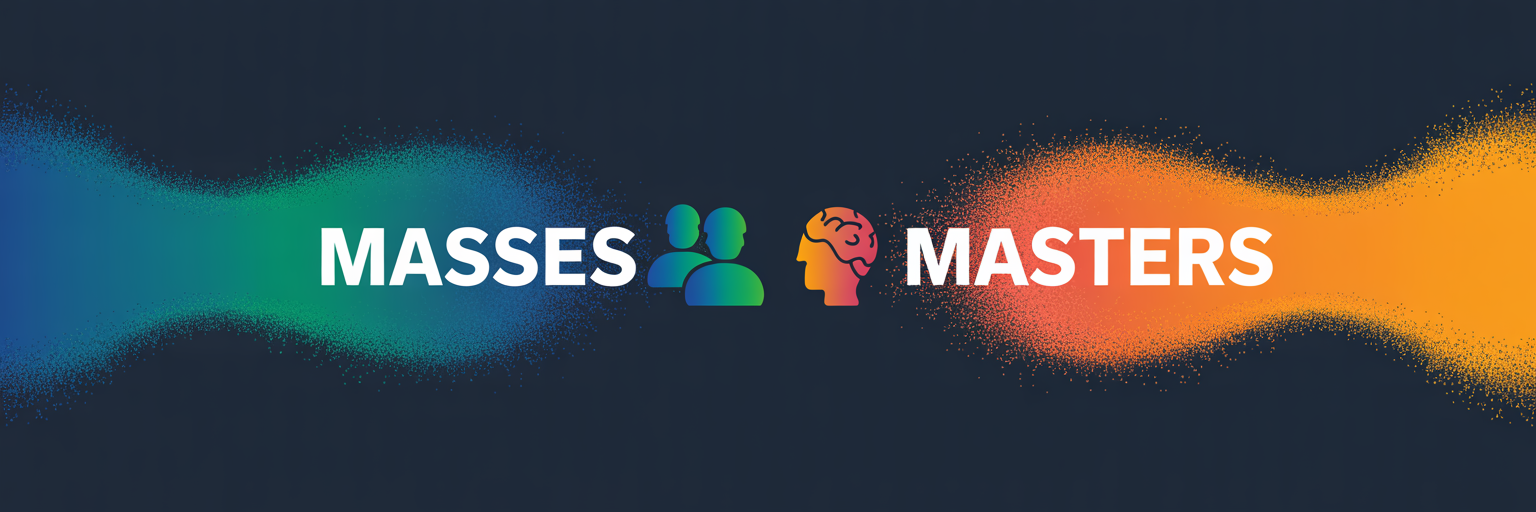The Masses and the Masters: Why GenAI Isn't One-Size-Fits-All
Here's what I've learned about AI adoption:
Everyone has their moment. That instant where they think, "I could not have done this without you, Claude!" or "ChatGPT just saved me hours!" The thing is, your breakthrough moment rarely impresses anyone else.
I've watched a finance person do cartwheels over AI-generated pivot tables while their marketing colleague shrugged. I've seen a designer flip out
about AI color palette suggestions, where I just….I dunno. I can’t get excited.
AI reveals what you already value, what you already understand, and where your expertise actually lies.
Which brings me to AI "democratization.”
Everyone's talking about how AI is "democratizing" capabilities. Making design accessible to non-designers. Making code accessible to non-coders. Making strategy accessible to non-strategists.
But democratization doesn't mean equality.
Canva absolutely democratized design. Before Canva, if you needed a professional-looking flyer, you either learned Photoshop (good luck with that) or hired a designer.
Canva changed that. Suddenly, anyone could make something decent.
But did Canva make everyone a designer? No.
Did it eliminate the value of real designers? Also no.
What it did was create two tiers:
The Masses: Can now make something presentable instead of something terrible.
The Masters: Can now create 10x more designs, 10x faster, while maintaining their expert eye for what actually works.
That’s what is happening with GenAI.
When a non-designer asks ChatGPT to "create a professional poster for my event," they'll get something serviceable. Maybe even good.
When an expert designer uses the same tools? They're not just making posters faster. They understand what great quality looks like. They know what to tweak and how to tweak it. They know what sells, what pops—they have a vision that I, as a non-designer, simply don't have.
It's why when we say Sora is going to make everyone a Hollywood director, it's ludicrous. The democratization helps the masses create. But it helps the masters dominate.
GenAI has the potential to amplify the gap between people who know what they're doing and people who don't. As long as you're actually using it.
Think about it this way:
For the masses:
GenAI removes the barrier of technical execution
It helps them produce something instead of nothing
It raises the floor of what's possible
For the masters:
GenAI accelerates their workflow by 10x
It amplifies their judgment and expertise
It raises the ceiling of what they can accomplish
Both are valuable. Both are important. But they're fundamentally different experiences.
WHY THIS MATTERS FOR YOU
The tool proficiency isn't what creates the gap.
The gap exists because expertise teaches you what to ask for.
Let me show you what I mean:
The novice might ask:
"Create a marketing strategy for my product"
On the other hand, a master would ask:
"Based on our customer data showing 60% mobile usage and peak engagement on weekday evenings, create a content calendar emphasizing short-form video on Instagram Reels and TikTok, with a focus on problem-solution storytelling that speaks to our 25-40 demographic's pain point around time scarcity. Include A/B testing framework for first two weeks."
See the difference?
The expert knows what information matters, what questions to ask, what good looks like, and how to iterate effectively.
GenAI doesn't give you that expertise. It amplifies the expertise you already have.
If you want to thrive with GenAI, stop focusing on the tools.
Start building your judgment in your domain. Learn what good looks like. Develop the expertise that lets you ask better questions and recognize better answers.
Because in a world where everyone has access to the same AI, your expertise is the only moat.
The masses get templates. The masters get multipliers.
Which one are you building toward?
AI NEWS OF THE WEEK
OpenAI announced that apps like Spotify, Canva, Zillow, Booking.com, Coursera, Figma, and Expedia can now integrate directly into ChatGPT conversations, with users able to create playlists, design presentations, search for homes, and book travel without leaving the chat. DoorDash, Instacart, Uber, and Target are coming soon. This is a big shift from trying to be everything to becoming the interface for everything.
2. Ive and Altman Screenless Delay
OpenAI and Jony Ive are developing a screen-less, AI device with AI, personality, privacy, and infrastructure challenges that may delay its 2026 launch. It will respond to audio and visual cues and may be 'always on,” raising control concerns.
eBay granted ChatGPT Enterprise access to 10,000 of its sellers to help them draft listings, respond to buyers, analyze performance metrics, and streamline operations. This is exactly the kind of scaled implementation that shows how businesses are moving from experimentation to execution.
GENERATIVE AI TIPS
When working with Canva through ChatGPT (or any design tool), here's the reality check:
If your first AI-generated design looks "good enough," you're probably in the masses category. And that's fine! But recognize it.
If you immediately see three things that need adjustment, you're building toward mastery.
REMEMBER:
Don't just accept the first output. Train yourself to spot what's wrong. Ask: "What would make this better?" That question—and your ability to answer it—is what separates the masses from the masters.
UPSKILL YOUR ORGANIZATION:
When your organization is ready to create an AI-powered culture—not just add tools—AI Mindset can help. We drive behavioral transformation at scale.


